Analyzing Smart Products and Business Intelligence for Competition
VerifiedAdded on 2023/06/14
|16
|2848
|436
Report
AI Summary
This report explores how business intelligence leverages data from smart, connected products to transform competition. It discusses the core elements of smart products, including physical, smart, and connectivity components, and how these elements disrupt value chains. The report outlines the four phases of the product cloud, emphasizing the role of analytics engines and big data in optimizing product functions. It further examines how companies are using smart technologies to improve services, reduce waiting times, and manage resources efficiently. The analysis highlights the importance of building new technology infrastructure, forming new customer relationships, and tailoring product features to gain a competitive advantage. Case studies, such as Schindler's elevator technology and Babolat's play pure technology, illustrate the practical applications of smart, connected products in various industries. The document is available on Desklib, a platform offering AI-based study tools and a wide range of academic resources for students.

Running head: BUSINESS INTELLIGENCE
Business Intelligence
Name of Student:
Name of University:
Author’s Note:
Business Intelligence
Name of Student:
Name of University:
Author’s Note:
Paraphrase This Document
Need a fresh take? Get an instant paraphrase of this document with our AI Paraphraser
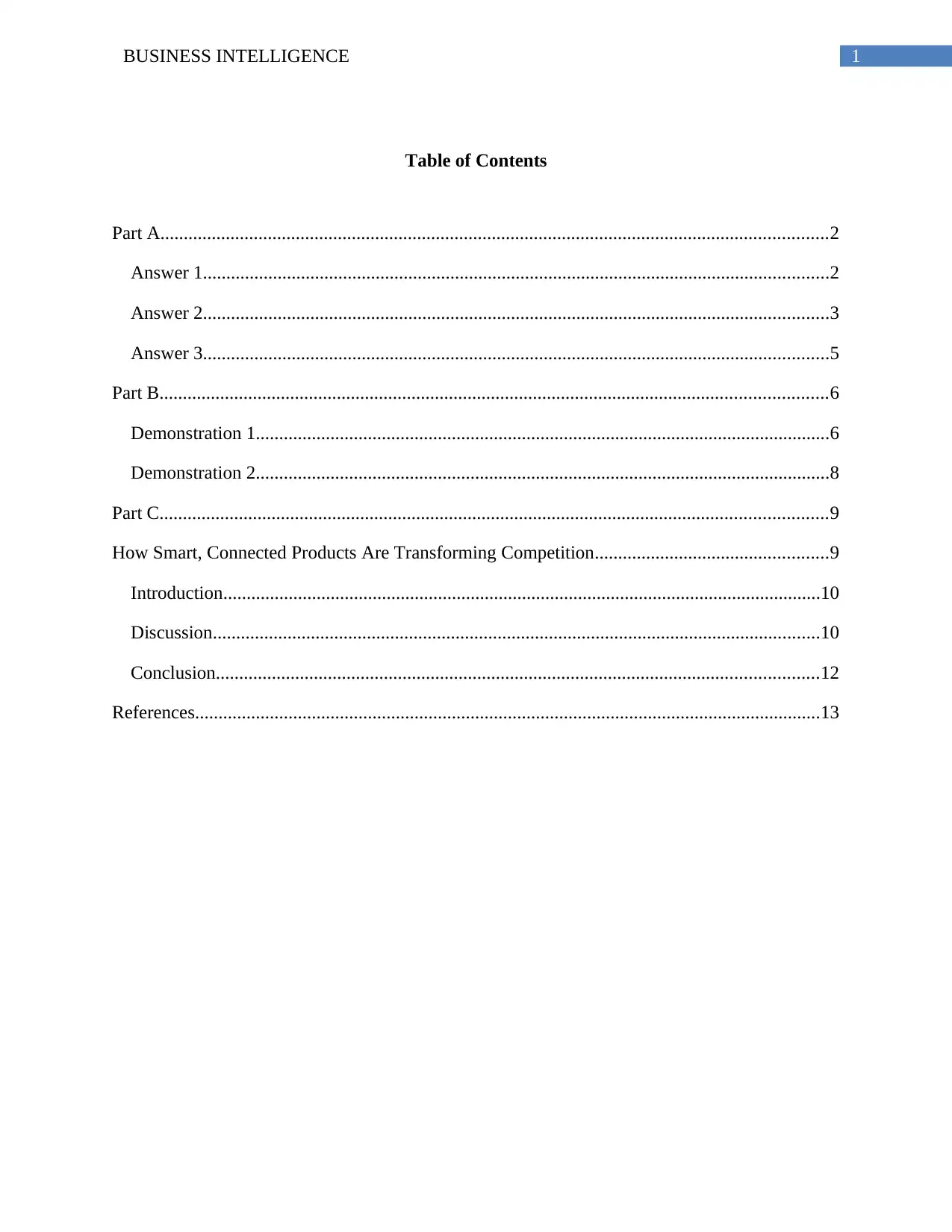
1BUSINESS INTELLIGENCE
Table of Contents
Part A...............................................................................................................................................2
Answer 1......................................................................................................................................2
Answer 2......................................................................................................................................3
Answer 3......................................................................................................................................5
Part B...............................................................................................................................................6
Demonstration 1...........................................................................................................................6
Demonstration 2...........................................................................................................................8
Part C...............................................................................................................................................9
How Smart, Connected Products Are Transforming Competition..................................................9
Introduction................................................................................................................................10
Discussion..................................................................................................................................10
Conclusion.................................................................................................................................12
References......................................................................................................................................13
Table of Contents
Part A...............................................................................................................................................2
Answer 1......................................................................................................................................2
Answer 2......................................................................................................................................3
Answer 3......................................................................................................................................5
Part B...............................................................................................................................................6
Demonstration 1...........................................................................................................................6
Demonstration 2...........................................................................................................................8
Part C...............................................................................................................................................9
How Smart, Connected Products Are Transforming Competition..................................................9
Introduction................................................................................................................................10
Discussion..................................................................................................................................10
Conclusion.................................................................................................................................12
References......................................................................................................................................13
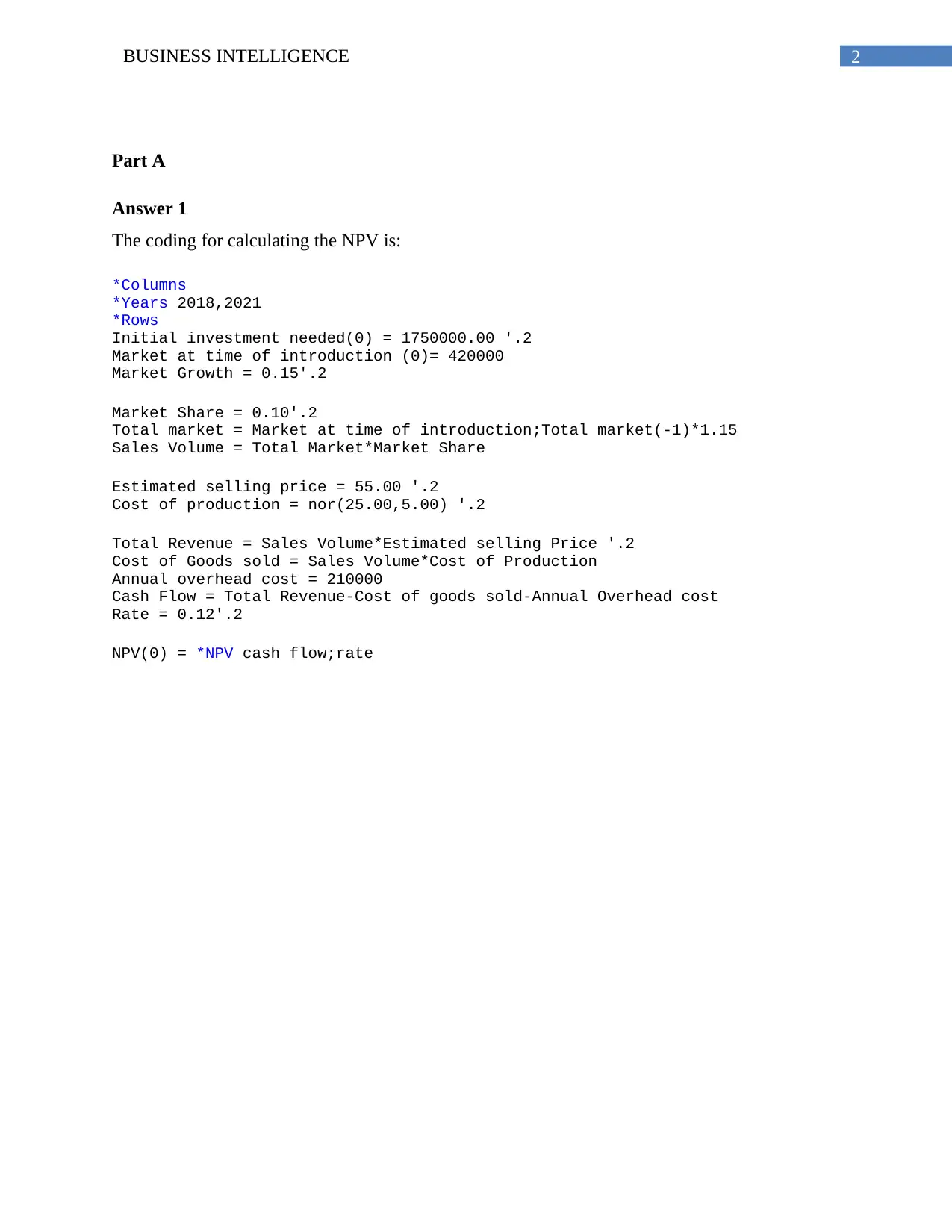
2BUSINESS INTELLIGENCE
Part A
Answer 1
The coding for calculating the NPV is:
*Columns
*Years 2018,2021
*Rows
Initial investment needed(0) = 1750000.00 '.2
Market at time of introduction (0)= 420000
Market Growth = 0.15'.2
Market Share = 0.10'.2
Total market = Market at time of introduction;Total market(-1)*1.15
Sales Volume = Total Market*Market Share
Estimated selling price = 55.00 '.2
Cost of production = nor(25.00,5.00) '.2
Total Revenue = Sales Volume*Estimated selling Price '.2
Cost of Goods sold = Sales Volume*Cost of Production
Annual overhead cost = 210000
Cash Flow = Total Revenue-Cost of goods sold-Annual Overhead cost
Rate = 0.12'.2
NPV(0) = *NPV cash flow;rate
Part A
Answer 1
The coding for calculating the NPV is:
*Columns
*Years 2018,2021
*Rows
Initial investment needed(0) = 1750000.00 '.2
Market at time of introduction (0)= 420000
Market Growth = 0.15'.2
Market Share = 0.10'.2
Total market = Market at time of introduction;Total market(-1)*1.15
Sales Volume = Total Market*Market Share
Estimated selling price = 55.00 '.2
Cost of production = nor(25.00,5.00) '.2
Total Revenue = Sales Volume*Estimated selling Price '.2
Cost of Goods sold = Sales Volume*Cost of Production
Annual overhead cost = 210000
Cash Flow = Total Revenue-Cost of goods sold-Annual Overhead cost
Rate = 0.12'.2
NPV(0) = *NPV cash flow;rate
⊘ This is a preview!⊘
Do you want full access?
Subscribe today to unlock all pages.

Trusted by 1+ million students worldwide
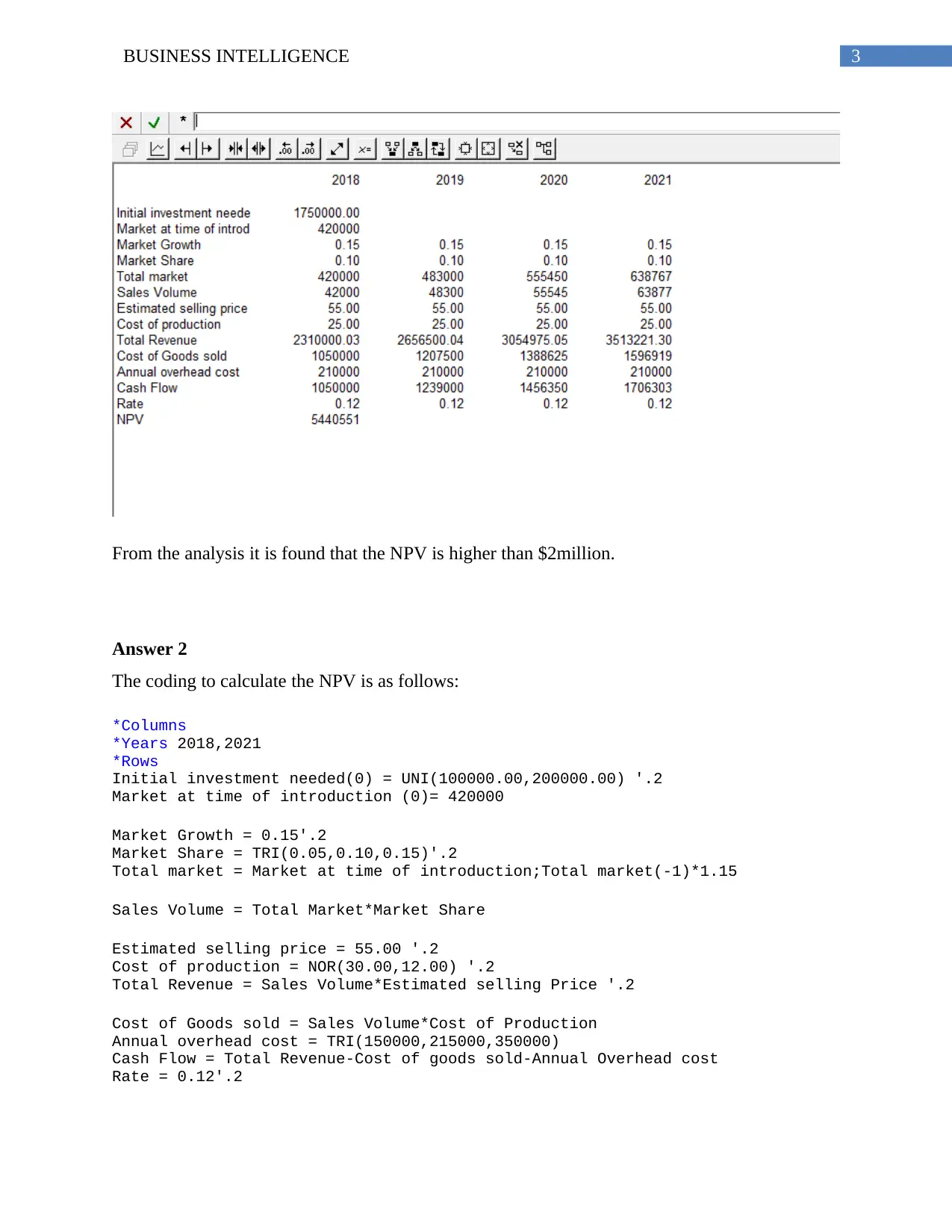
3BUSINESS INTELLIGENCE
From the analysis it is found that the NPV is higher than $2million.
Answer 2
The coding to calculate the NPV is as follows:
*Columns
*Years 2018,2021
*Rows
Initial investment needed(0) = UNI(100000.00,200000.00) '.2
Market at time of introduction (0)= 420000
Market Growth = 0.15'.2
Market Share = TRI(0.05,0.10,0.15)'.2
Total market = Market at time of introduction;Total market(-1)*1.15
Sales Volume = Total Market*Market Share
Estimated selling price = 55.00 '.2
Cost of production = NOR(30.00,12.00) '.2
Total Revenue = Sales Volume*Estimated selling Price '.2
Cost of Goods sold = Sales Volume*Cost of Production
Annual overhead cost = TRI(150000,215000,350000)
Cash Flow = Total Revenue-Cost of goods sold-Annual Overhead cost
Rate = 0.12'.2
From the analysis it is found that the NPV is higher than $2million.
Answer 2
The coding to calculate the NPV is as follows:
*Columns
*Years 2018,2021
*Rows
Initial investment needed(0) = UNI(100000.00,200000.00) '.2
Market at time of introduction (0)= 420000
Market Growth = 0.15'.2
Market Share = TRI(0.05,0.10,0.15)'.2
Total market = Market at time of introduction;Total market(-1)*1.15
Sales Volume = Total Market*Market Share
Estimated selling price = 55.00 '.2
Cost of production = NOR(30.00,12.00) '.2
Total Revenue = Sales Volume*Estimated selling Price '.2
Cost of Goods sold = Sales Volume*Cost of Production
Annual overhead cost = TRI(150000,215000,350000)
Cash Flow = Total Revenue-Cost of goods sold-Annual Overhead cost
Rate = 0.12'.2
Paraphrase This Document
Need a fresh take? Get an instant paraphrase of this document with our AI Paraphraser
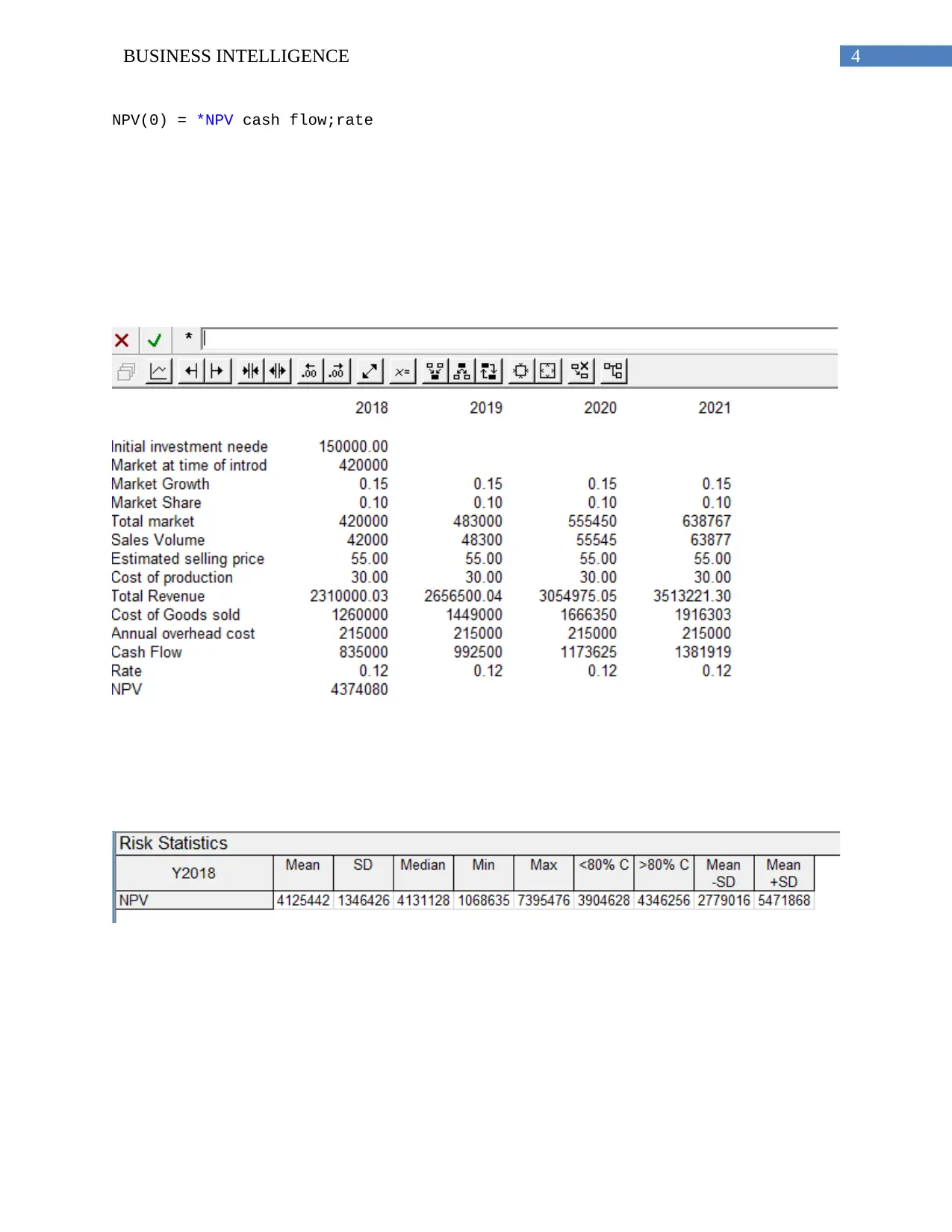
4BUSINESS INTELLIGENCE
NPV(0) = *NPV cash flow;rate
NPV(0) = *NPV cash flow;rate
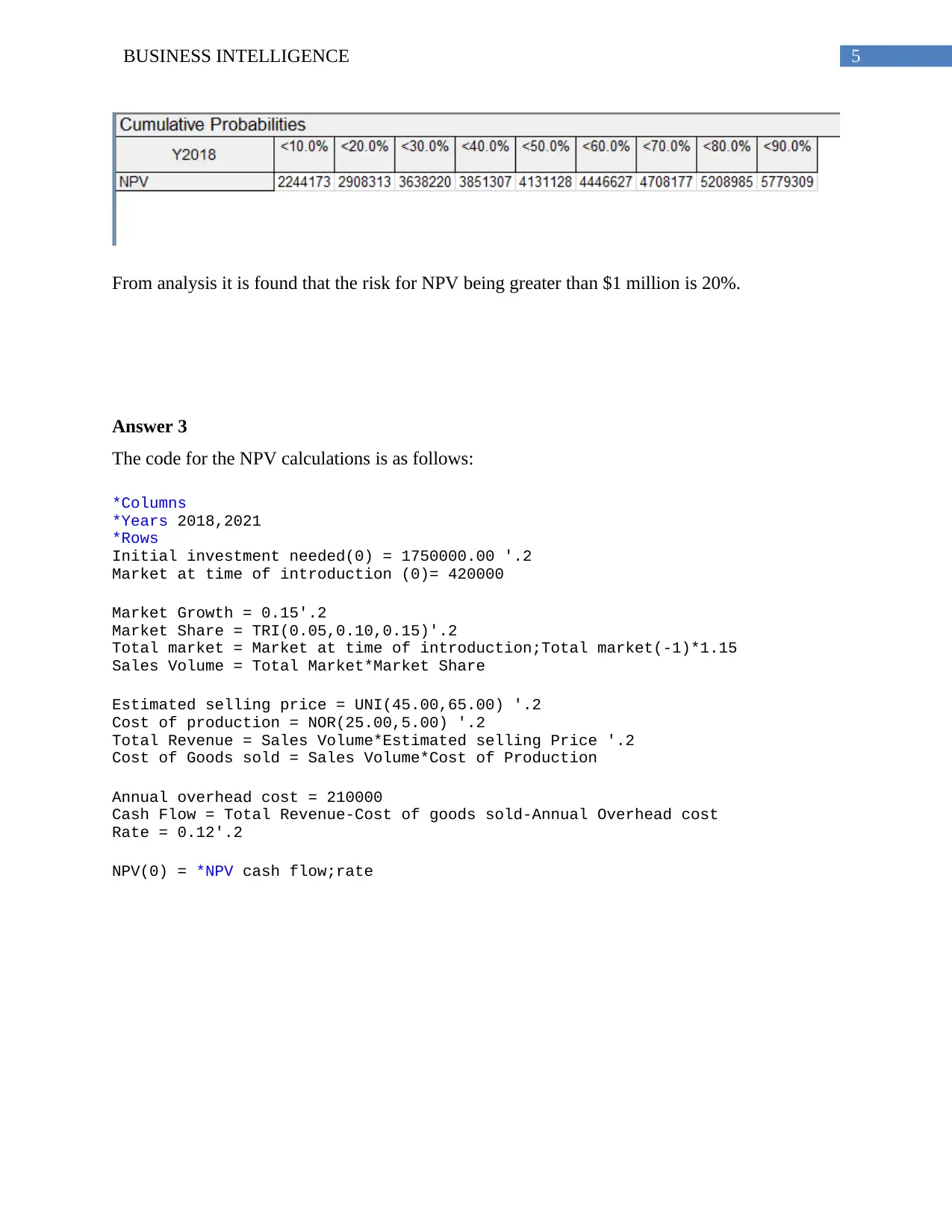
5BUSINESS INTELLIGENCE
From analysis it is found that the risk for NPV being greater than $1 million is 20%.
Answer 3
The code for the NPV calculations is as follows:
*Columns
*Years 2018,2021
*Rows
Initial investment needed(0) = 1750000.00 '.2
Market at time of introduction (0)= 420000
Market Growth = 0.15'.2
Market Share = TRI(0.05,0.10,0.15)'.2
Total market = Market at time of introduction;Total market(-1)*1.15
Sales Volume = Total Market*Market Share
Estimated selling price = UNI(45.00,65.00) '.2
Cost of production = NOR(25.00,5.00) '.2
Total Revenue = Sales Volume*Estimated selling Price '.2
Cost of Goods sold = Sales Volume*Cost of Production
Annual overhead cost = 210000
Cash Flow = Total Revenue-Cost of goods sold-Annual Overhead cost
Rate = 0.12'.2
NPV(0) = *NPV cash flow;rate
From analysis it is found that the risk for NPV being greater than $1 million is 20%.
Answer 3
The code for the NPV calculations is as follows:
*Columns
*Years 2018,2021
*Rows
Initial investment needed(0) = 1750000.00 '.2
Market at time of introduction (0)= 420000
Market Growth = 0.15'.2
Market Share = TRI(0.05,0.10,0.15)'.2
Total market = Market at time of introduction;Total market(-1)*1.15
Sales Volume = Total Market*Market Share
Estimated selling price = UNI(45.00,65.00) '.2
Cost of production = NOR(25.00,5.00) '.2
Total Revenue = Sales Volume*Estimated selling Price '.2
Cost of Goods sold = Sales Volume*Cost of Production
Annual overhead cost = 210000
Cash Flow = Total Revenue-Cost of goods sold-Annual Overhead cost
Rate = 0.12'.2
NPV(0) = *NPV cash flow;rate
⊘ This is a preview!⊘
Do you want full access?
Subscribe today to unlock all pages.

Trusted by 1+ million students worldwide
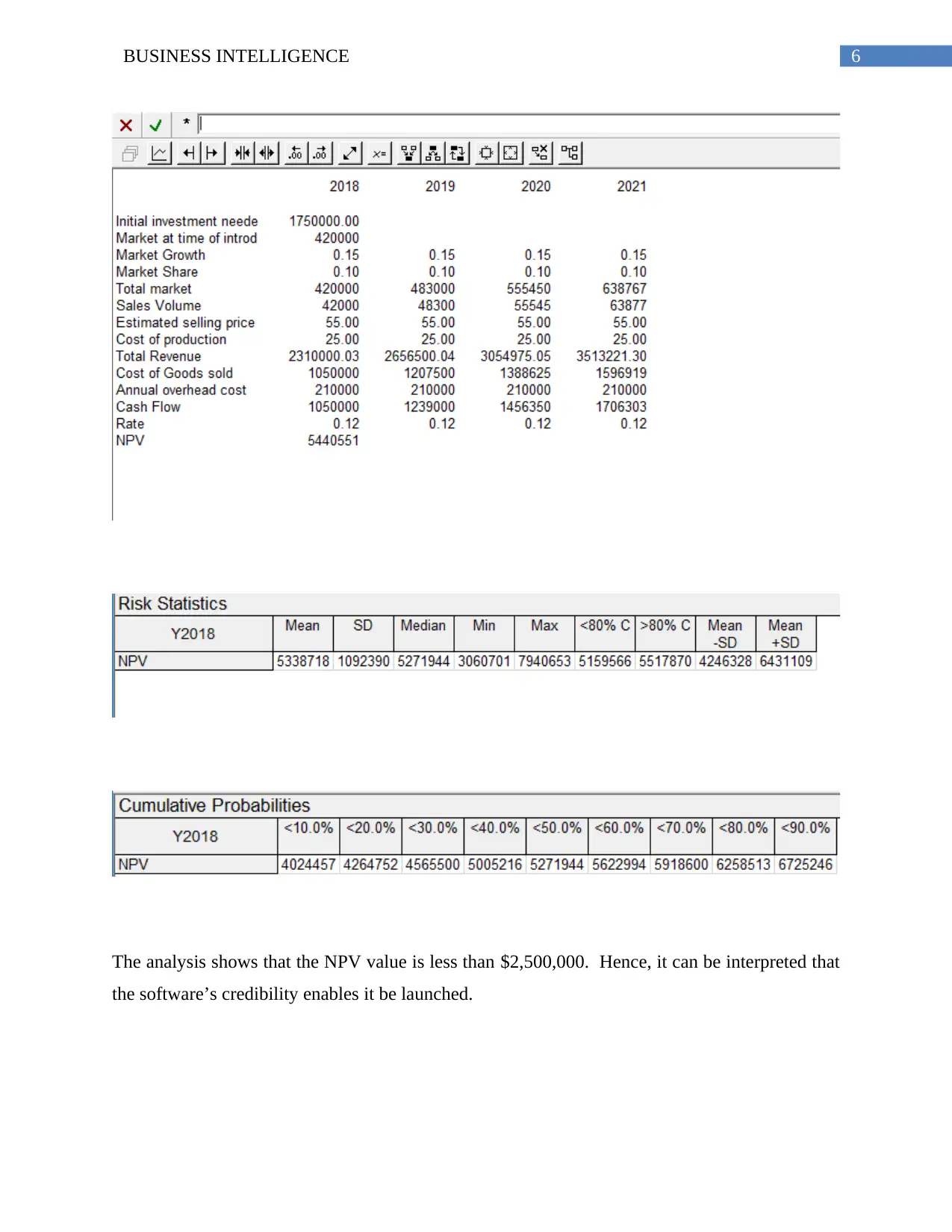
6BUSINESS INTELLIGENCE
The analysis shows that the NPV value is less than $2,500,000. Hence, it can be interpreted that
the software’s credibility enables it be launched.
The analysis shows that the NPV value is less than $2,500,000. Hence, it can be interpreted that
the software’s credibility enables it be launched.
Paraphrase This Document
Need a fresh take? Get an instant paraphrase of this document with our AI Paraphraser
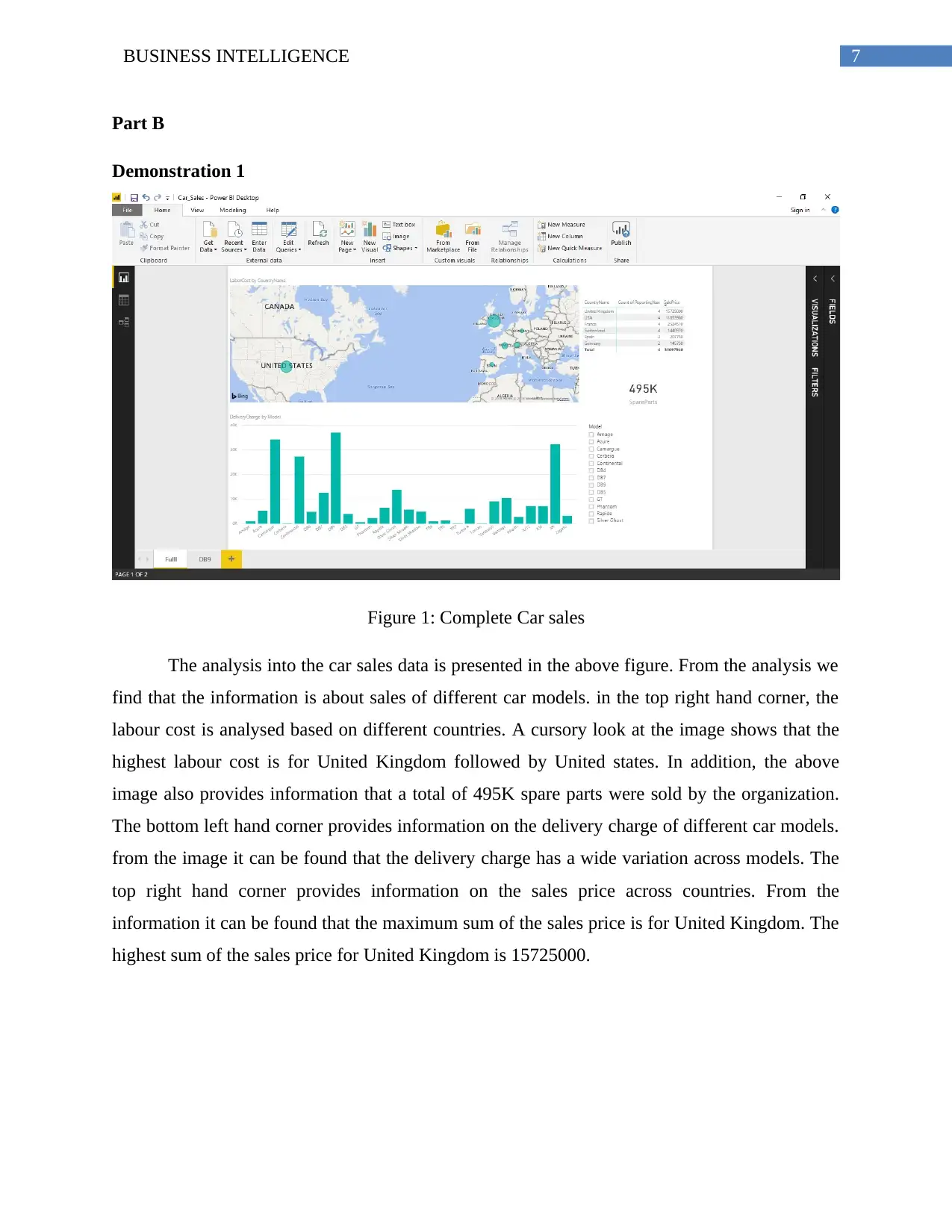
7BUSINESS INTELLIGENCE
Part B
Demonstration 1
Figure 1: Complete Car sales
The analysis into the car sales data is presented in the above figure. From the analysis we
find that the information is about sales of different car models. in the top right hand corner, the
labour cost is analysed based on different countries. A cursory look at the image shows that the
highest labour cost is for United Kingdom followed by United states. In addition, the above
image also provides information that a total of 495K spare parts were sold by the organization.
The bottom left hand corner provides information on the delivery charge of different car models.
from the image it can be found that the delivery charge has a wide variation across models. The
top right hand corner provides information on the sales price across countries. From the
information it can be found that the maximum sum of the sales price is for United Kingdom. The
highest sum of the sales price for United Kingdom is 15725000.
Part B
Demonstration 1
Figure 1: Complete Car sales
The analysis into the car sales data is presented in the above figure. From the analysis we
find that the information is about sales of different car models. in the top right hand corner, the
labour cost is analysed based on different countries. A cursory look at the image shows that the
highest labour cost is for United Kingdom followed by United states. In addition, the above
image also provides information that a total of 495K spare parts were sold by the organization.
The bottom left hand corner provides information on the delivery charge of different car models.
from the image it can be found that the delivery charge has a wide variation across models. The
top right hand corner provides information on the sales price across countries. From the
information it can be found that the maximum sum of the sales price is for United Kingdom. The
highest sum of the sales price for United Kingdom is 15725000.
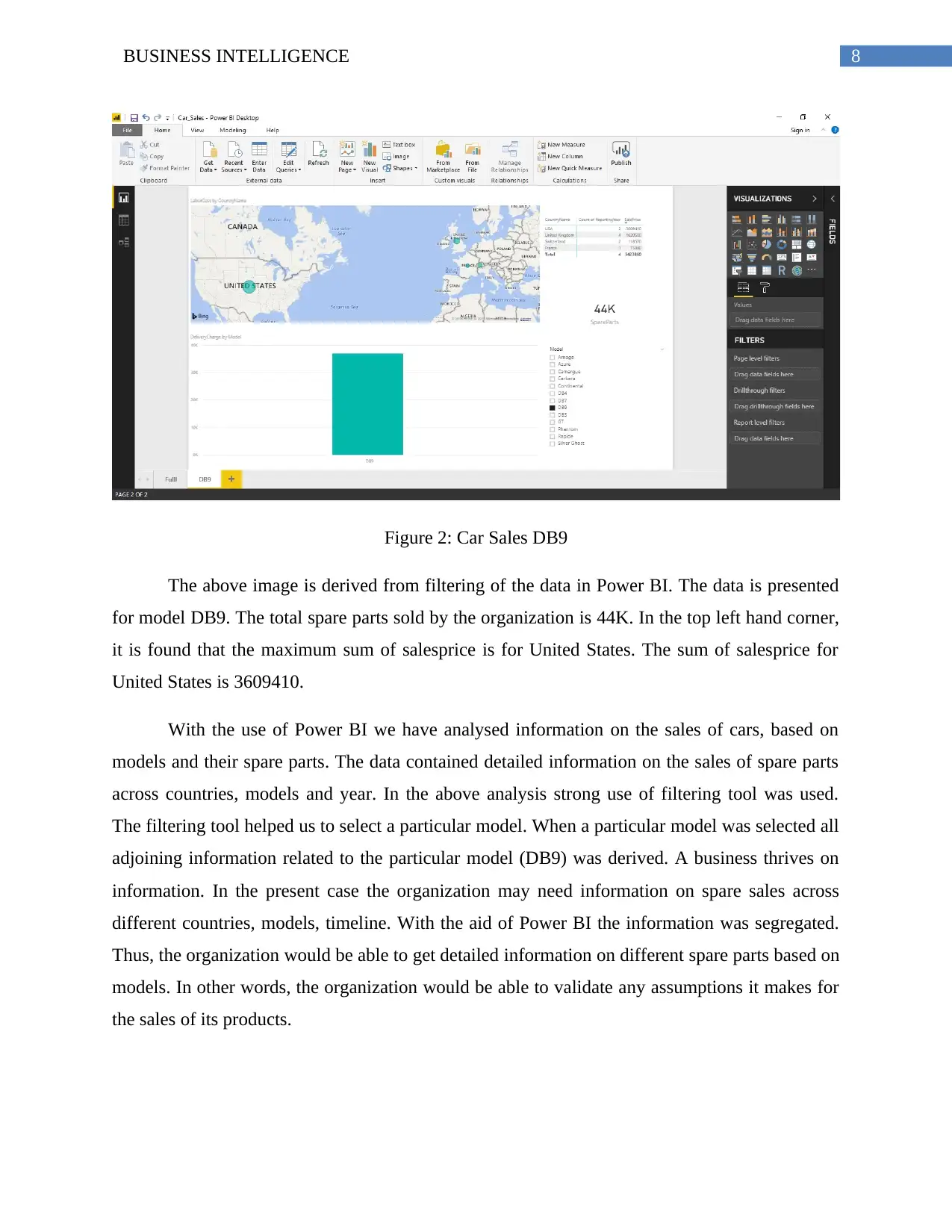
8BUSINESS INTELLIGENCE
Figure 2: Car Sales DB9
The above image is derived from filtering of the data in Power BI. The data is presented
for model DB9. The total spare parts sold by the organization is 44K. In the top left hand corner,
it is found that the maximum sum of salesprice is for United States. The sum of salesprice for
United States is 3609410.
With the use of Power BI we have analysed information on the sales of cars, based on
models and their spare parts. The data contained detailed information on the sales of spare parts
across countries, models and year. In the above analysis strong use of filtering tool was used.
The filtering tool helped us to select a particular model. When a particular model was selected all
adjoining information related to the particular model (DB9) was derived. A business thrives on
information. In the present case the organization may need information on spare sales across
different countries, models, timeline. With the aid of Power BI the information was segregated.
Thus, the organization would be able to get detailed information on different spare parts based on
models. In other words, the organization would be able to validate any assumptions it makes for
the sales of its products.
Figure 2: Car Sales DB9
The above image is derived from filtering of the data in Power BI. The data is presented
for model DB9. The total spare parts sold by the organization is 44K. In the top left hand corner,
it is found that the maximum sum of salesprice is for United States. The sum of salesprice for
United States is 3609410.
With the use of Power BI we have analysed information on the sales of cars, based on
models and their spare parts. The data contained detailed information on the sales of spare parts
across countries, models and year. In the above analysis strong use of filtering tool was used.
The filtering tool helped us to select a particular model. When a particular model was selected all
adjoining information related to the particular model (DB9) was derived. A business thrives on
information. In the present case the organization may need information on spare sales across
different countries, models, timeline. With the aid of Power BI the information was segregated.
Thus, the organization would be able to get detailed information on different spare parts based on
models. In other words, the organization would be able to validate any assumptions it makes for
the sales of its products.
⊘ This is a preview!⊘
Do you want full access?
Subscribe today to unlock all pages.

Trusted by 1+ million students worldwide
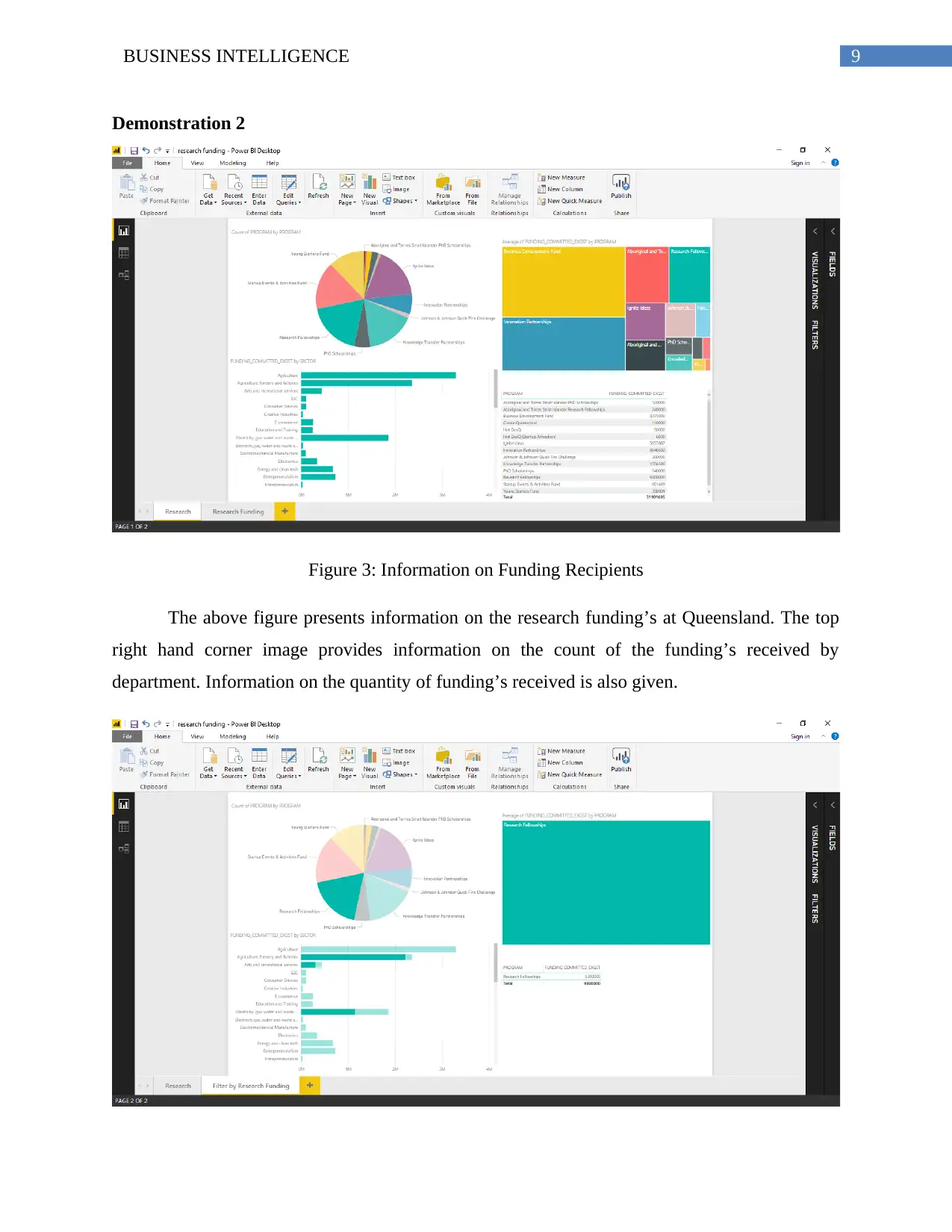
9BUSINESS INTELLIGENCE
Demonstration 2
Figure 3: Information on Funding Recipients
The above figure presents information on the research funding’s at Queensland. The top
right hand corner image provides information on the count of the funding’s received by
department. Information on the quantity of funding’s received is also given.
Demonstration 2
Figure 3: Information on Funding Recipients
The above figure presents information on the research funding’s at Queensland. The top
right hand corner image provides information on the count of the funding’s received by
department. Information on the quantity of funding’s received is also given.
Paraphrase This Document
Need a fresh take? Get an instant paraphrase of this document with our AI Paraphraser
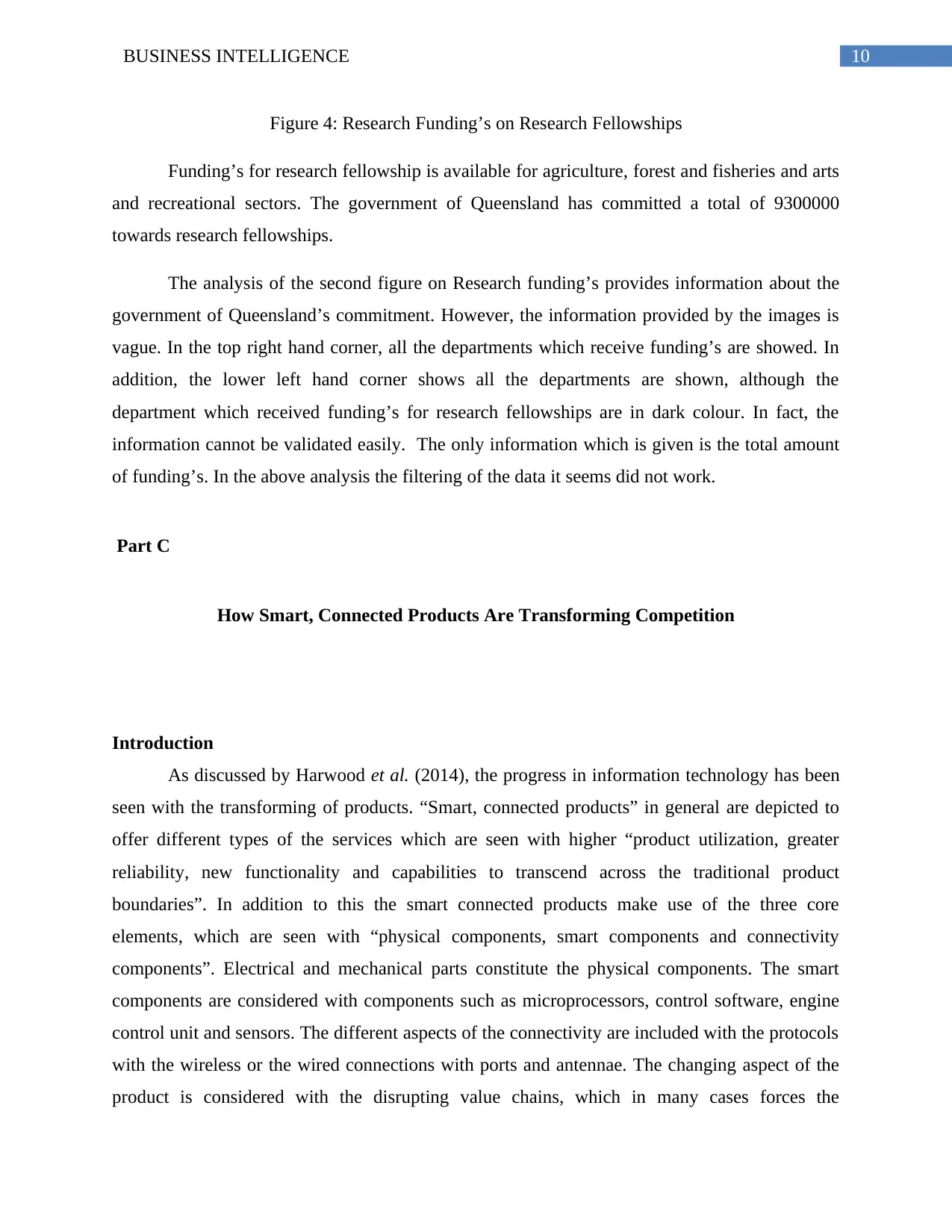
10BUSINESS INTELLIGENCE
Figure 4: Research Funding’s on Research Fellowships
Funding’s for research fellowship is available for agriculture, forest and fisheries and arts
and recreational sectors. The government of Queensland has committed a total of 9300000
towards research fellowships.
The analysis of the second figure on Research funding’s provides information about the
government of Queensland’s commitment. However, the information provided by the images is
vague. In the top right hand corner, all the departments which receive funding’s are showed. In
addition, the lower left hand corner shows all the departments are shown, although the
department which received funding’s for research fellowships are in dark colour. In fact, the
information cannot be validated easily. The only information which is given is the total amount
of funding’s. In the above analysis the filtering of the data it seems did not work.
Part C
How Smart, Connected Products Are Transforming Competition
Introduction
As discussed by Harwood et al. (2014), the progress in information technology has been
seen with the transforming of products. “Smart, connected products” in general are depicted to
offer different types of the services which are seen with higher “product utilization, greater
reliability, new functionality and capabilities to transcend across the traditional product
boundaries”. In addition to this the smart connected products make use of the three core
elements, which are seen with “physical components, smart components and connectivity
components”. Electrical and mechanical parts constitute the physical components. The smart
components are considered with components such as microprocessors, control software, engine
control unit and sensors. The different aspects of the connectivity are included with the protocols
with the wireless or the wired connections with ports and antennae. The changing aspect of the
product is considered with the disrupting value chains, which in many cases forces the
Figure 4: Research Funding’s on Research Fellowships
Funding’s for research fellowship is available for agriculture, forest and fisheries and arts
and recreational sectors. The government of Queensland has committed a total of 9300000
towards research fellowships.
The analysis of the second figure on Research funding’s provides information about the
government of Queensland’s commitment. However, the information provided by the images is
vague. In the top right hand corner, all the departments which receive funding’s are showed. In
addition, the lower left hand corner shows all the departments are shown, although the
department which received funding’s for research fellowships are in dark colour. In fact, the
information cannot be validated easily. The only information which is given is the total amount
of funding’s. In the above analysis the filtering of the data it seems did not work.
Part C
How Smart, Connected Products Are Transforming Competition
Introduction
As discussed by Harwood et al. (2014), the progress in information technology has been
seen with the transforming of products. “Smart, connected products” in general are depicted to
offer different types of the services which are seen with higher “product utilization, greater
reliability, new functionality and capabilities to transcend across the traditional product
boundaries”. In addition to this the smart connected products make use of the three core
elements, which are seen with “physical components, smart components and connectivity
components”. Electrical and mechanical parts constitute the physical components. The smart
components are considered with components such as microprocessors, control software, engine
control unit and sensors. The different aspects of the connectivity are included with the protocols
with the wireless or the wired connections with ports and antennae. The changing aspect of the
product is considered with the disrupting value chains, which in many cases forces the
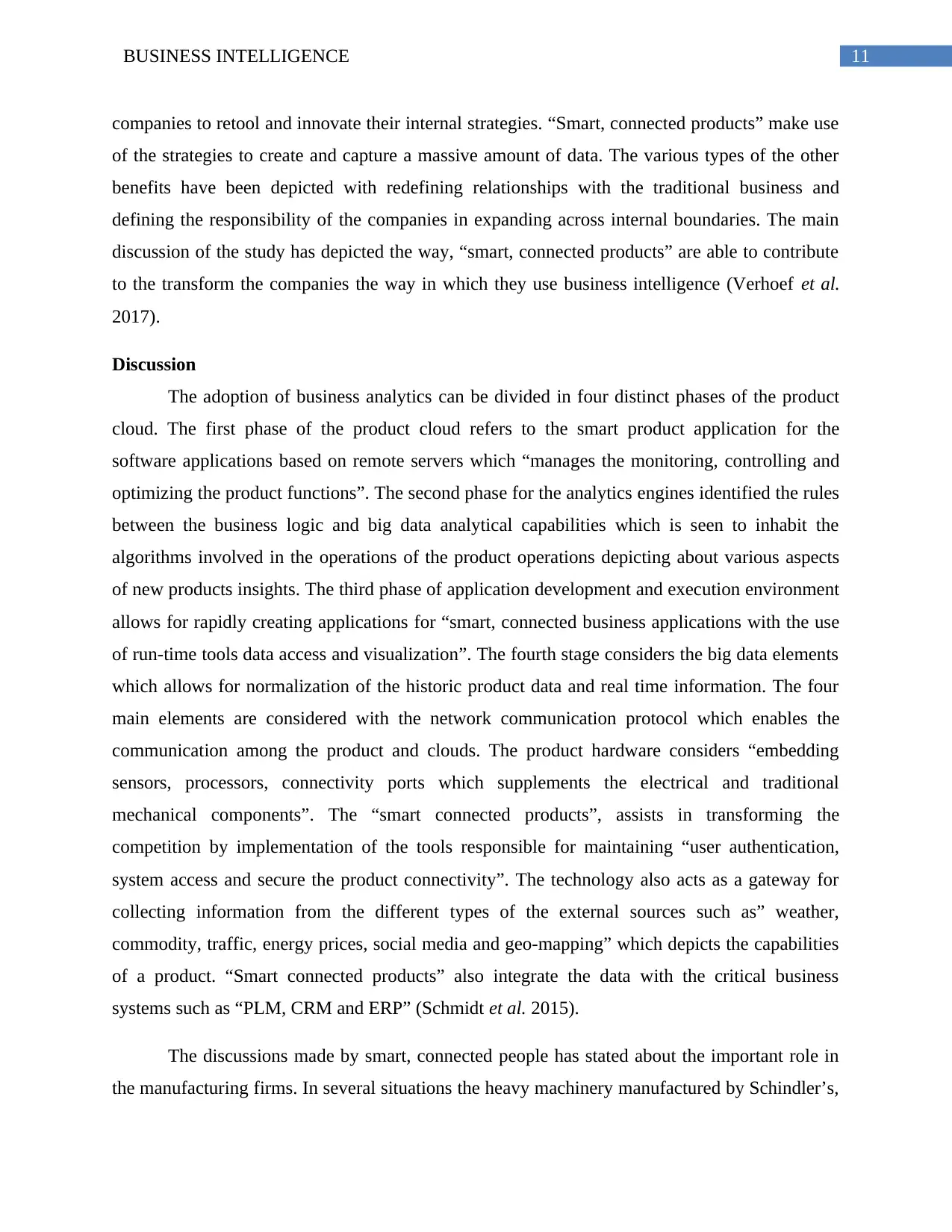
11BUSINESS INTELLIGENCE
companies to retool and innovate their internal strategies. “Smart, connected products” make use
of the strategies to create and capture a massive amount of data. The various types of the other
benefits have been depicted with redefining relationships with the traditional business and
defining the responsibility of the companies in expanding across internal boundaries. The main
discussion of the study has depicted the way, “smart, connected products” are able to contribute
to the transform the companies the way in which they use business intelligence (Verhoef et al.
2017).
Discussion
The adoption of business analytics can be divided in four distinct phases of the product
cloud. The first phase of the product cloud refers to the smart product application for the
software applications based on remote servers which “manages the monitoring, controlling and
optimizing the product functions”. The second phase for the analytics engines identified the rules
between the business logic and big data analytical capabilities which is seen to inhabit the
algorithms involved in the operations of the product operations depicting about various aspects
of new products insights. The third phase of application development and execution environment
allows for rapidly creating applications for “smart, connected business applications with the use
of run-time tools data access and visualization”. The fourth stage considers the big data elements
which allows for normalization of the historic product data and real time information. The four
main elements are considered with the network communication protocol which enables the
communication among the product and clouds. The product hardware considers “embedding
sensors, processors, connectivity ports which supplements the electrical and traditional
mechanical components”. The “smart connected products”, assists in transforming the
competition by implementation of the tools responsible for maintaining “user authentication,
system access and secure the product connectivity”. The technology also acts as a gateway for
collecting information from the different types of the external sources such as” weather,
commodity, traffic, energy prices, social media and geo-mapping” which depicts the capabilities
of a product. “Smart connected products” also integrate the data with the critical business
systems such as “PLM, CRM and ERP” (Schmidt et al. 2015).
The discussions made by smart, connected people has stated about the important role in
the manufacturing firms. In several situations the heavy machinery manufactured by Schindler’s,
companies to retool and innovate their internal strategies. “Smart, connected products” make use
of the strategies to create and capture a massive amount of data. The various types of the other
benefits have been depicted with redefining relationships with the traditional business and
defining the responsibility of the companies in expanding across internal boundaries. The main
discussion of the study has depicted the way, “smart, connected products” are able to contribute
to the transform the companies the way in which they use business intelligence (Verhoef et al.
2017).
Discussion
The adoption of business analytics can be divided in four distinct phases of the product
cloud. The first phase of the product cloud refers to the smart product application for the
software applications based on remote servers which “manages the monitoring, controlling and
optimizing the product functions”. The second phase for the analytics engines identified the rules
between the business logic and big data analytical capabilities which is seen to inhabit the
algorithms involved in the operations of the product operations depicting about various aspects
of new products insights. The third phase of application development and execution environment
allows for rapidly creating applications for “smart, connected business applications with the use
of run-time tools data access and visualization”. The fourth stage considers the big data elements
which allows for normalization of the historic product data and real time information. The four
main elements are considered with the network communication protocol which enables the
communication among the product and clouds. The product hardware considers “embedding
sensors, processors, connectivity ports which supplements the electrical and traditional
mechanical components”. The “smart connected products”, assists in transforming the
competition by implementation of the tools responsible for maintaining “user authentication,
system access and secure the product connectivity”. The technology also acts as a gateway for
collecting information from the different types of the external sources such as” weather,
commodity, traffic, energy prices, social media and geo-mapping” which depicts the capabilities
of a product. “Smart connected products” also integrate the data with the critical business
systems such as “PLM, CRM and ERP” (Schmidt et al. 2015).
The discussions made by smart, connected people has stated about the important role in
the manufacturing firms. In several situations the heavy machinery manufactured by Schindler’s,
⊘ This is a preview!⊘
Do you want full access?
Subscribe today to unlock all pages.

Trusted by 1+ million students worldwide
1 out of 16
Related Documents
Your All-in-One AI-Powered Toolkit for Academic Success.
+13062052269
info@desklib.com
Available 24*7 on WhatsApp / Email
![[object Object]](/_next/static/media/star-bottom.7253800d.svg)
Unlock your academic potential
Copyright © 2020–2025 A2Z Services. All Rights Reserved. Developed and managed by ZUCOL.





